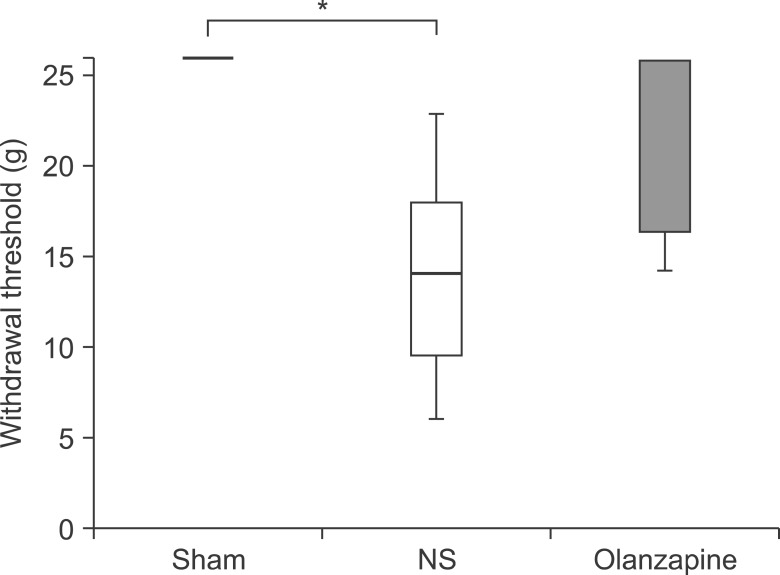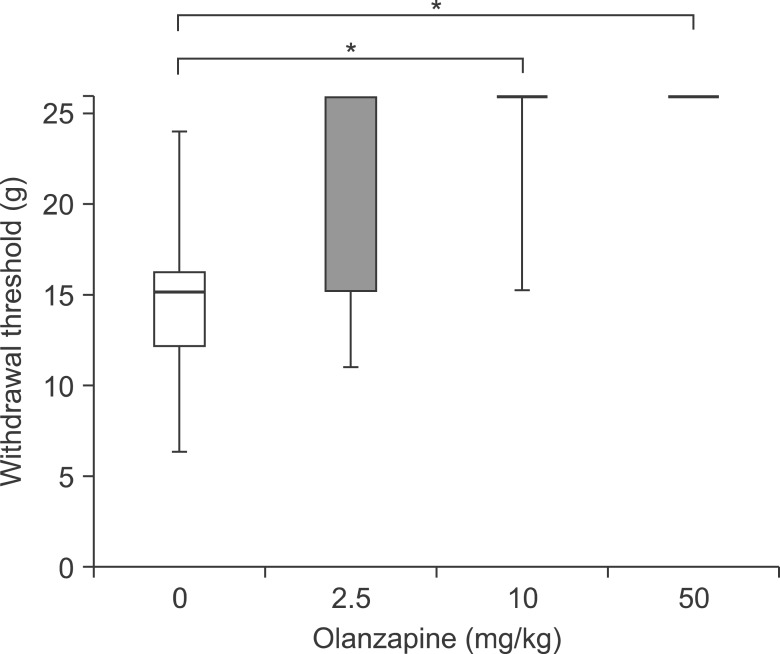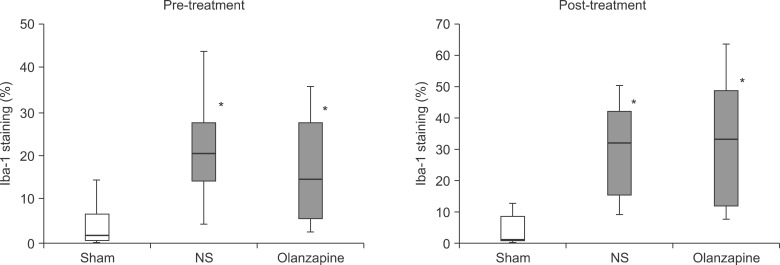Korean J Pain.
2015 Jul;28(3):185-192. 10.3344/kjp.2015.28.3.185.
Olanzapine Attenuates Mechanical Allodynia in a Rat Model of Partial Sciatic Nerve Ligation
- Affiliations
-
- 1Department of Anesthesiology, University of Tsukuba, Tsukuba, Japan. taekof@md.tsukuba.ac.jp
- 2Laboratory of Neuroendocrinology, Faculty of Medicine, University of Tsukuba, Tsukuba, Japan.
- KMID: 2149462
- DOI: http://doi.org/10.3344/kjp.2015.28.3.185
Abstract
- BACKGROUND
Neuropathic pain is a global clinical problem; nevertheless, nerve injury treatment methods remain limited. Olanzapine has antinociceptive and anti-nueropathic properties; however, its preventive effects have not been assessed in nerve injury models.
METHODS
We prepared a partial sciatic nerve ligation (Seltzer model) or sham-operated model in male Sprague-Dawley rats under isoflurane anesthesia. In a pre-treatment study, we administered olanzapine (10 mg/kg) intraperitoneally 1 h before nerve ligation. In post-treatment and dose-dependent studies, we injected 3 different doses of olanzapine intraperitoneally 1 h after nerve ligation. Mechanical allodynia was measured before and 7 days after surgery. Immunohistochemical analysis using anti-Iba-1 antibody was used to assess the effect of olanzapine at the spinal level.
RESULTS
In the pre-treatment study, median withdrawal thresholds of the normal saline groups were significantly lower than those of the sham-operated groups; however, those of the olanzapine (10 mg/kg) and sham-operated groups were not different. In the post-treatment and dose-dependent studies, the median withdrawal thresholds of the olanzapine (2.5 mg/kg) and normal saline groups were not different; however, those of the olanzapine (10 and 50 mg/kg) groups were significantly higher than those of the normal saline groups. Olanzapine did not have a significant effect on the density of Iba-1 staining.
CONCLUSIONS
Olanzapine attenuated mechanical allodynia dose-dependently in the Seltzer model. This anti-allodynic effect of olanzapine was observed even when injected 1 h after nerve ligation. This effect of olanzapine appeared to be unrelated to microglia activation in the ipsilateral dorsal horn of the lumbar spinal cord.
Keyword
MeSH Terms
Figure
Reference
-
1. Yawn BP, Wollan PC, Weingarten TN, Watson JC, Hooten WM, Melton LJ 3rd. The prevalence of neuropathic pain: clinical evaluation compared with screening tools in a community population. Pain Med. 2009; 10:586–593. PMID: 20849570.
Article2. Lecomte F, Gault N, Koné V, Lafoix C, Ginsburg C, Claessens YE, et al. Prevalence of neuropathic pain in emergency patients: an observational study. Am J Emerg Med. 2011; 29:43–49. PMID: 20825773.
Article3. Johansen A, Romundstad L, Nielsen CS, Schirmer H, Stubhaug A. Persistent postsurgical pain in a general population: prevalence and predictors in the Tromsø study. Pain. 2012; 153:1390–1396. PMID: 22445291.
Article4. Lee JB, Choi SS, Ahn EH, Hahm KD, Suh JH, Leem JG, et al. Effect of perioperative perineural injection of dexamethasone and bupivacaine on a rat spared nerve injury model. Korean J Pain. 2010; 23:166–171. PMID: 20830261.
Article5. Jung KT, Lee HY, Yoon MH, Lim KJ. The effect of urinary trypsin inhibitor against neuropathic pain in rat models. Korean J Pain. 2013; 26:356–360. PMID: 24156001.
Article6. Moini Zanjani T, Ameli H, Labibi F, Sedaghat K, Sabetkasaei M. The attenuation of pain behavior and serum COX-2 concentration by curcumin in a rat model of neuropathic pain. Korean J Pain. 2014; 27:246–252. PMID: 25031810.
Article7. Bymaster F, Perry KW, Nelson DL, Wong DT, Rasmussen K, Moore NA, et al. Olanzapine: a basic science update. Br J Psychiatry Suppl. 1999; 36–40. PMID: 10211140.
Article8. Glazer WM. Extrapyramidal side effects, tardive dyskinesia, and the concept of atypicality. J Clin Psychiatry. 2000; 61(Suppl 3):16–21. PMID: 10724129.9. Schreiber S, Getslev V, Backer MM, Weizman R, Pick CG. The atypical neuroleptics clozapine and olanzapine differ regarding their antinociceptive mechanisms and potency. Pharmacol Biochem Behav. 1999; 64:75–80. PMID: 10495000.
Article10. Kiser RS, Cohen HM, Freedenfeld RN, Jewell C, Fuchs PN. Olanzapine for the treatment of fibromyalgia symptoms. J Pain Symptom Manage. 2001; 22:704–708. PMID: 11495717.
Article11. Khojainova N, Santiago-Palma J, Kornick C, Breitbart W, Gonzales GR. Olanzapine in the management of cancer pain. J Pain Symptom Manage. 2002; 23:346–350. PMID: 11997204.
Article12. Silberstein SD, Peres MF, Hopkins MM, Shechter AL, Young WB, Rozen TD. Olanzapine in the treatment of refractory migraine and chronic daily headache. Headache. 2002; 42:515–518. PMID: 12167140.
Article13. Gorski ED, Willis KC. Report of three case studies with olanzapine for chronic pain. J Pain. 2003; 4:166–168. PMID: 14622714.
Article14. Rico-Villademoros F, Hidalgo J, Dominguez I, García-Leiva JM, Calandre EP. Atypical antipsychotics in the treatment of fibromyalgia: a case series with olanzapine. Prog Neuropsychopharmacol Biol Psychiatry. 2005; 29:161–164. PMID: 15610961.
Article15. Freedenfeld RN, Murray M, Fuchs PN, Kiser RS. Decreased pain and improved quality of life in fibromyalgia patients treated with olanzapine, an atypical neuroleptic. Pain Pract. 2006; 6:112–118. PMID: 17309719.
Article16. Torigoe K, Nakahara K, Rahmadi M, Yoshizawa K, Horiuchi H, Hirayama S, et al. Usefulness of olanzapine as an adjunct to opioid treatment and for the treatment of neuropathic pain. Anesthesiology. 2012; 116:159–169. PMID: 22126917.
Article17. Tsuda M, Inoue K, Salter MW. Neuropathic pain and spinal microglia: a big problem from molecules in "small" glia. Trends Neurosci. 2005; 28:101–107. PMID: 15667933.
Article18. Ji RR, Suter MR. p38 MAPK, microglial signaling, and neuropathic pain. Mol Pain. 2007; 3:33. PMID: 17974036.
Article19. Talbot S, Chahmi E, Dias JP, Couture R. Key role for spinal dorsal horn microglial kinin B1 receptor in early diabetic pain neuropathy. J Neuroinflammation. 2010; 7:36. PMID: 20587056.20. Chu YX, Zhang YQ, Zhao ZQ. Involvement of microglia and interleukin-18 in the induction of long-term potentiation of spinal nociceptive responses induced by tetanic sciatic stimulation. Neurosci Bull. 2012; 28:49–60. PMID: 22233889.
Article21. Mika J, Osikowicz M, Rojewska E, Korostynski M, Wawrzczak-Bargiela A, Przewlocki R, et al. Differential activation of spinal microglial and astroglial cells in a mouse model of peripheral neuropathic pain. Eur J Pharmacol. 2009; 623:65–72. PMID: 19766105.
Article22. Seltzer Z, Dubner R, Shir Y. A novel behavioral model of neuropathic pain disorders produced in rats by partial sciatic nerve injury. Pain. 1990; 43:205–218. PMID: 1982347.
Article23. Meyer JM, Simpson GM. From chlorpromazine to olanzapine: a brief history of antipsychotics. Psychiatr Serv. 1997; 48:1137–1139. PMID: 9285972.
Article24. Wang HH, Xu SF. Effect of D1 and D2 dopamine receptor antagonists on acupuncture analgesia. Sheng Li Xue Bao. 1993; 45:61–68. PMID: 8503031.25. Aravagiri M, Teper Y, Marder SR. Pharmacokinetics and tissue distribution of olanzapine in rats. Biopharm Drug Dispos. 1999; 20:369–377. PMID: 10870093.
Article26. Marx CE, VanDoren MJ, Duncan GE, Lieberman JA, Morrow AL. Olanzapine and clozapine increase the GABAergic neuroactive steroid allopregnanolone in rodents. Neuropsychopharmacology. 2003; 28:1–13. PMID: 12496935.
Article27. Djebaili M, Guo Q, Pettus EH, Hoffman SW, Stein DG. The neurosteroids progesterone and allopregnanolone reduce cell death, gliosis, and functional deficits after traumatic brain injury in rats. J Neurotrauma. 2005; 22:106–118. PMID: 15665606.
Article28. Meyer L, Patte-Mensah C, Taleb O, Mensah-Nyagan AG. Allopregnanolone prevents and suppresses oxaliplatin-evoked painful neuropathy: multi-parametric assessment and direct evidence. Pain. 2011; 152:170–181. PMID: 21071147.
Article29. Kawano T, Soga T, Chi H, Eguchi S, Yamazaki F, Kumagai N, et al. Role of the neurosteroid allopregnanolone in the hyperalgesic behavior induced by painful nerve injury in rats. J Anesth. 2011; 25:942–945. PMID: 21879341.
Article30. Kuner R. Central mechanisms of pathological pain. Nat Med. 2010; 16:1258–1266. PMID: 20948531.
Article31. Zhang G, Terry AV Jr, Bartlett MG. Sensitive liquid chromatography tandem mass spectrometry method for the simultaneous determination of olanzapine, risperidone, 9-hydroxyrisperidone, clozapine, haloperidol and ziprasidone in rat brain tissue. J Chromatogr B Analyt Technol Biomed Life Sci. 2007; 858:276–281.
Article
- Full Text Links
- Actions
-
Cited
- CITED
-
- Close
- Share
- Similar articles
-
- Effects of Chemical Sympathectomy in the Causalgiform Pain Produced by Unilateral Partial Ligation of Sciatic Nerve in Rats
- Development of Neuropathic Pain Model with 1% Phenol Injection in Rat Sciatic Nerve
- The Effect of Phosphodiesterase-4-Specific Inhibitor in the Rat Model of Spinal Nerve Ligation
- Effect of Administering Freund's Complete Adjuvant to Spinal Nerves on the Development of Allodynia in the Rat
- Effects of Orally Administered Baclofen in the Animal Model for Neuropathic Pain






